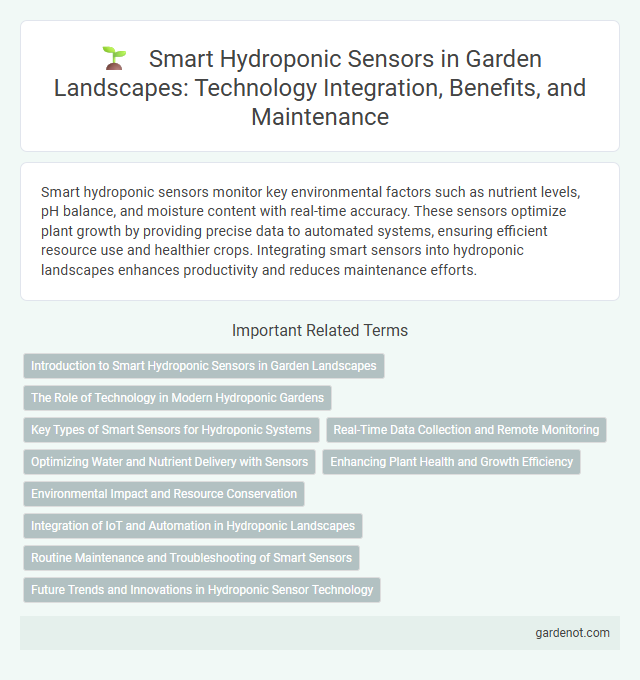Smart hydroponic sensors monitor key environmental factors such as nutrient levels, pH balance, and moisture content with real-time accuracy. These sensors optimize plant growth by providing precise data to automated systems, ensuring efficient resource use and healthier crops. Integrating smart sensors into hydroponic landscapes enhances productivity and reduces maintenance efforts.
Introduction to Smart Hydroponic Sensors in Garden Landscapes
Smart hydroponic sensors integrate advanced technology to monitor and manage nutrient levels, pH, and moisture in garden landscapes, ensuring optimal plant growth conditions. These sensors provide real-time data, allowing for precise adjustments in water and nutrient delivery systems, which enhances plant health and yield. By using IoT-enabled devices, smart hydroponic sensors enable automated control and efficient resource management in sustainable garden landscapes.
The Role of Technology in Modern Hydroponic Gardens
Smart hydroponic sensors play a crucial role in modern hydroponic gardens by continuously monitoring key parameters such as nutrient levels, pH, temperature, and humidity to optimize plant growth. These sensors enable precise adjustments through real-time data analytics, improving crop yields and resource efficiency while reducing waste. Integration of IoT technology facilitates remote management and automated control, enhancing productivity and sustainability in hydroponic systems.
Key Types of Smart Sensors for Hydroponic Systems
Key types of smart hydroponic sensors essential for optimizing plant growth include pH sensors, which monitor nutrient solution acidity to maintain ideal levels between 5.5 and 6.5. Electrical Conductivity (EC) sensors measure the concentration of dissolved salts, ensuring nutrient availability aligns with crop-specific requirements. Oxygen sensors track dissolved oxygen levels in the water, vital for root respiration and preventing anaerobic conditions that hinder plant development.
Real-Time Data Collection and Remote Monitoring
Smart hydroponic sensors enable real-time data collection by continuously monitoring key parameters such as pH levels, nutrient concentration, temperature, and humidity, ensuring optimal growing conditions. These sensors support remote monitoring through wireless connectivity, allowing growers to track crop health and system performance from any location via mobile apps or web platforms. Integrating smart sensors enhances crop yield, reduces water usage, and enables timely interventions to prevent plant stress or disease.
Optimizing Water and Nutrient Delivery with Sensors
Smart hydroponic sensors enhance water and nutrient delivery by continuously monitoring parameters such as pH, electrical conductivity, and moisture levels, enabling precise adjustments in real-time. These sensors help maintain optimal environmental conditions, reducing water waste and ensuring balanced nutrient absorption for healthier plant growth. Integrating advanced IoT technology with hydroponic systems maximizes resource efficiency and boosts crop yields.
Enhancing Plant Health and Growth Efficiency
Smart hydroponic sensors monitor essential parameters such as pH levels, nutrient concentration, and moisture in real time, optimizing conditions for plant health and maximizing growth efficiency. These advanced sensors enable precise adjustments to the hydroponic system, reducing resource wastage and preventing nutrient imbalances that can hinder plant development. Integrating IoT technology allows continuous data analysis, ensuring plants receive optimal care tailored to their specific growth stages.
Environmental Impact and Resource Conservation
Smart hydroponic sensors optimize water and nutrient usage by continuously monitoring environmental conditions such as pH, humidity, and temperature, significantly reducing waste and minimizing the need for excessive chemical inputs. These sensors enable precise adjustments that conserve water resources and lower energy consumption, thereby decreasing the overall environmental footprint of hydroponic farming. By enhancing resource efficiency and promoting sustainable practices, smart hydroponic sensors contribute to more eco-friendly indoor landscapes.
Integration of IoT and Automation in Hydroponic Landscapes
Smart hydroponic sensors leverage IoT technology to monitor nutrient levels, pH balance, and environmental conditions in real time, optimizing plant growth in hydroponic landscapes. Automated systems use data from these sensors to adjust water flow, lighting, and nutrient delivery with high precision, reducing human error and resource waste. Integration of IoT enables remote monitoring and control through connected devices, enhancing scalability and efficiency in hydroponic farming operations.
Routine Maintenance and Troubleshooting of Smart Sensors
Routine maintenance of smart hydroponic sensors involves regular calibration, cleaning of sensor probes, and firmware updates to ensure precise data accuracy. Troubleshooting common issues requires checking connections for corrosion, validating sensor readings against manual measurements, and resetting the device to resolve software glitches. Consistent upkeep and prompt diagnosis extend sensor lifespan and optimize nutrient delivery in hydroponic systems.
Future Trends and Innovations in Hydroponic Sensor Technology
Smart hydroponic sensors are poised to revolutionize urban farming by integrating AI-driven analytics and IoT connectivity for real-time nutrient and pH monitoring. Future innovations will emphasize enhanced multispectral sensing capabilities to precisely track plant health and growth metrics, optimizing resource use and crop yield. Advancements in miniaturized, wireless sensor technology will enable seamless scalability and remote management of large hydroponic landscapes.
Smart hydroponic sensor Infographic

 gardenot.com
gardenot.com